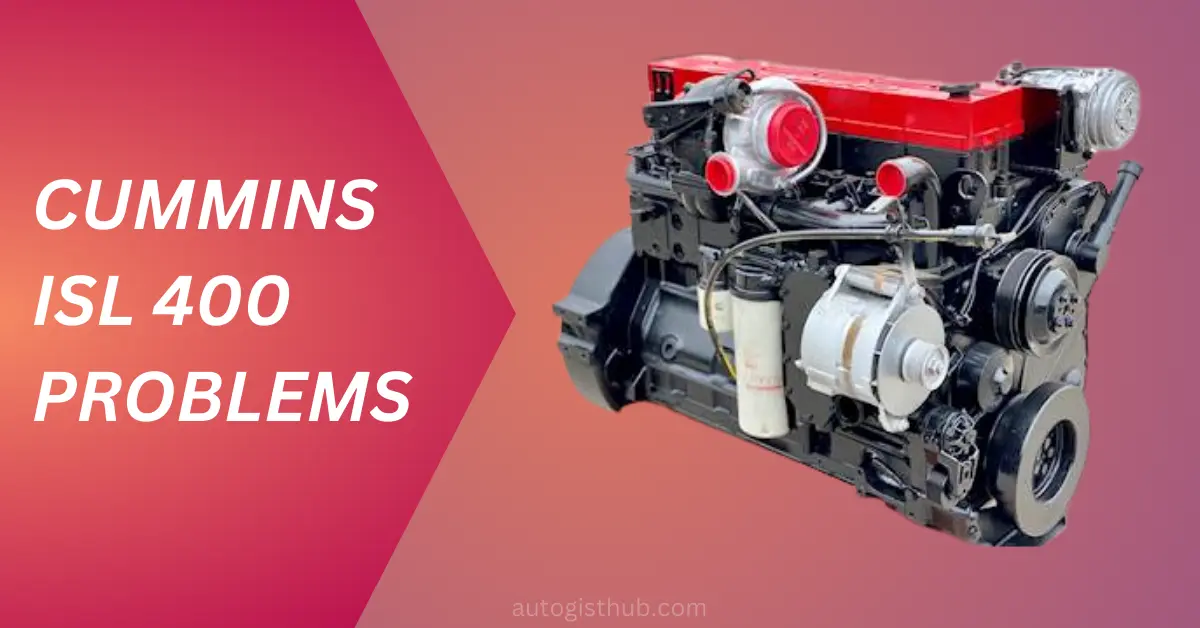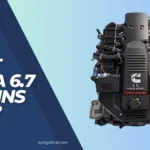The Cummins ISL 400 engine has a few common issues that users may encounter. These are Exhaust leaks, EGR system malfunctions, Turbocharger problems, Injector issues, and Cooling system failures. The Cummins ISL 400 engine, although highly regarded for its performance, can experience a range of problems.
These problems can include issues such as injector failures, turbocharger failures, and problems with the EGR system. Injector failures can lead to misfires, reduced engine power, and increased fuel consumption. Turbocharger failures can result in a loss of power and engine performance.
Problems with the EGR system can cause excessive exhaust gas recirculation, leading to a decrease in engine efficiency and increased emissions. Regular maintenance and prompt addressing of these issues can help ensure the longevity and optimal performance of the Cummins ISL 400 engine.
Cooling System Issues
The cooling system is an essential component of the Cummins ISL 400 engine, as it regulates the temperature to prevent overheating and maintain proper engine performance. However, like any mechanical system, it can encounter various problems that require attention.
Overheating and Coolant Leaks
One of the major concerns with the Cummins ISL 400 cooling system is the risk of overheating, which can lead to severe engine damage if not addressed promptly. Common causes of overheating include a malfunctioning water pump, clogged radiator, or restricted airflow due to debris or a faulty fan. When the engine temperature continues to rise, it puts stress on other components and increases the chances of a breakdown.
In addition to overheating, another common issue is coolant leaks. Coolant is responsible for transferring heat away from the engine, and any leakage can disrupt this process. Leaks can occur from various points in the cooling system, such as the radiator, hoses, or the water pump gasket.
If coolant levels are consistently decreasing or you notice puddles of coolant under your vehicle, it is essential to inspect and repair the leaks as soon as possible to prevent engine damage.
Malfunctioning Thermostat and Radiator Problems
The thermostat plays a crucial role in regulating the engine temperature by controlling coolant flow. If the thermostat malfunctions, it can cause the engine to overheat or run at lower temperatures, affecting performance and fuel efficiency. A malfunctioning thermostat needs to be replaced promptly to ensure the cooling system operates optimally.
Radiator problems can also lead to cooling system issues. A clogged or damaged radiator can hinder the proper airflow necessary for heat dissipation. This can result in overheating and potential damage to the engine. Regular maintenance, such as cleaning the radiator fins and inspecting for any signs of damage, is crucial in avoiding such problems.
Identifying Common Issues
As a proud owner of a Cummins ISL 400 engine, it is essential to be aware of the common problems that may arise. By understanding these issues, you can take prompt action to resolve them, ensuring optimal performance and longevity for your engine.
Common Problems Faced By Cummins Isl 400 Engine Owners
Cummins ISL 400 engines are known for their reliability and power, but like any machinery, they can experience certain issues. Being aware of these common problems will help you identify and address them before they cause major disruptions. Here are some of the most frequently encountered problems:
- Exhaust leaks: Over time, exhaust leaks can occur due to wear and tear on gaskets and seals. These leaks can lead to decreased engine performance, increased fuel consumption, and emission issues. Regular inspection can help detect and fix these leaks promptly.
- EGR system malfunctions: The Exhaust Gas Recirculation (EGR) system in the Cummins ISL 400 is designed to reduce emissions. However, it can sometimes malfunction, leading to increased emissions, reduced fuel efficiency, and potential engine damage. Prompt inspection and cleaning of the EGR system can help prevent these issues.
- Turbocharger problems: The turbocharger plays a crucial role in enhancing engine performance. However, it can experience issues such as oil leakage, turbine damage, or compressor failure. Timely inspection and maintenance of the turbocharger can prevent performance degradation and costly repairs.
- Injector issues: Injectors are vital components of the fuel system, responsible for delivering precise amounts of fuel into each cylinder. Over time, injectors can become clogged or worn out, leading to poor fuel economy, rough idling, or even engine misfires. Regular cleaning and maintenance of injectors can prevent these issues.
- Cooling system failures: The Cummins ISL 400 relies on an effective cooling system to regulate engine temperature. Coolant leaks, malfunctioning thermostats, or radiator problems can cause the engine to overheat, leading to reduced performance and potential damage. Regular inspection and maintenance of the cooling system are crucial.
Signs and Symptoms of Faulty Components
Identifying signs and symptoms of faulty components can help you diagnose the issues with your Cummins ISL 400 engine accurately. Here are some key indicators to look out for:
- Decreased engine power or acceleration
- Increase in fuel consumption
- Abnormal exhaust smoke or odor
- Engine misfires or rough idling
- Overheating or coolant leaks
- Strange noises or vibrations
- Poor fuel economy
- Dashboard warning lights or error codes
If you notice any of these signs, it’s crucial to address them promptly to prevent further damage and ensure optimal engine performance. Consulting a professional mechanic or Cummins authorized service center can help you identify and resolve the root cause of these issues.
Engine Performance Problems
When it comes to the Cummins ISL 400 engine, there are a few common performance problems that owners may encounter. These issues can affect the overall driving experience and require attention to ensure optimal engine performance.
In this section, we will discuss two of the most prevalent engine performance problems: loss of power and reduced acceleration, and excessive fuel consumption and poor fuel efficiency.
Loss Of Power and Reduced Acceleration
One of the most frustrating problems that Cummins ISL 400 owners may face is a noticeable loss of power and reduced acceleration. This can make it difficult to navigate steep inclines or overtake other vehicles, resulting in a less enjoyable driving experience. Several factors can contribute to this problem:
- Worn or damaged fuel injectors: Over time, fuel injectors may become clogged or malfunction, leading to a decrease in fuel delivery and subsequent power loss. Regular inspection and maintenance of the fuel injectors can help prevent this issue.
- Problems with the turbocharger: The turbocharger plays a crucial role in enhancing engine power. If the turbocharger is faulty or damaged, it can result in reduced acceleration and power output. Regular inspection and cleaning of the turbocharger can help prevent this problem.
- Restrictions in the air intake system: An inefficient or clogged air intake system can restrict airflow to the engine, leading to reduced power and acceleration. Regularly cleaning or replacing air filters can help prevent this issue.
Excessive Fuel Consumption and Poor Fuel Efficiency
Another common engine performance issue that Cummins ISL 400 owners may encounter is excessive fuel consumption and poor fuel efficiency. This can be costly in the long run and may indicate underlying problems with the engine. Here are a few possible causes for this problem:
- Incorrect fuel injector calibration: A misaligned or improperly calibrated fuel injector can lead to excessive fuel consumption. Regular calibration checks and adjustments can resolve this issue.
- Malfunctioning sensors: Faulty sensors can provide incorrect information to the engine control unit, resulting in an imbalance in the fuel-to-air ratio and poor fuel efficiency. Regular sensor inspections and replacements can help address this problem.
- Ignition system issues: Problems in the ignition system, such as worn-out spark plugs or ignition coils, can cause incomplete combustion, leading to increased fuel consumption. Regular maintenance of the ignition system can help improve fuel efficiency.
By addressing these engine performance problems promptly and regularly maintaining your Cummins ISL 400 engine, you can ensure a smoother driving experience, improved fuel efficiency, and overall better performance.
Electrical and Sensor Failures
When it comes to the performance and reliability of the Cummins ISL 400 engine, there are a few common problems that owners may encounter. One area of concern is electrical and sensor failures, which can lead to various issues and impact the overall functioning of the engine.
Faulty Sensors and Warning Lights
A well-functioning engine relies on accurate readings from various sensors to ensure optimal performance. However, faulty sensors can disrupt this delicate balance and cause performance issues. In the case of the Cummins ISL 400, malfunctioning sensors can lead to warning lights being activated, indicating potential problems within the engine.
One common sensor failure is the coolant temperature sensor. When this sensor fails, it may send incorrect temperature readings to the engine control module (ECM), resulting in poor fuel efficiency, power loss, or even engine overheating. Similarly, a faulty oil pressure sensor can trigger warning lights, leading to oil pressure-related issues if not addressed promptly.
Another sensor that can cause problems is the crankshaft position sensor. This sensor is responsible for monitoring the position and speed of the crankshaft. If it fails, the ECM may not receive accurate information, causing starting issues or even stalling while driving.
Starting Issues and Electrical System Malfunctions:
In addition to sensor failures, electrical system malfunctions can also plague the Cummins ISL 400 engine. Starting issues, for instance, can be caused by a weak battery, a failing starter motor, or a faulty ignition switch. These problems can result in delays or difficulties starting the engine, which can be incredibly frustrating.
Moreover, the electrical system serves a crucial role in the overall functioning of the engine, facilitating communication between various components and providing power to essential systems. Any malfunction within the electrical system can lead to a host of issues. For example, failing alternators or faulty wiring can result in battery drain, causing the engine to shut down unexpectedly.
It is important to address these electrical and sensor failures promptly to prevent further damage and ensure the optimal performance of your Cummins ISL 400 engine. Regular maintenance and inspections can help identify and resolve these issues before they escalate, keeping your engine running smoothly.
Maintenance and Repair Solutions
Regular maintenance and timely repairs are essential for keeping your Cummins ISL 400 engine running smoothly and avoiding potential problems down the road. In this section, we will provide you with valuable tips for regular maintenance and discuss repair options for common issues that may arise.
Regular Maintenance Tips for Cummins Isl 400 Engine
Maintaining your Cummins ISL 400 engine is crucial to ensure optimal performance and longevity. By following these regular maintenance tips, you can keep your engine in top shape:
- Change the oil and filters regularly: Regular oil changes, along with the replacement of oil filters, help remove impurities and protect the engine from wear and tear.
- Inspect and replace belts: Inspect the belts for signs of wear, such as cracks or fraying. Replace them if necessary to prevent unexpected failures.
- Check and maintain proper coolant levels: Ensure that the coolant is at the recommended level and check for any leaks that may affect the cooling system’s efficiency.
- Inspect and clean the air filter: A clogged air filter can decrease engine performance. Regularly inspect and clean or replace the air filter to maintain smooth airflow.
- Monitor and maintain appropriate fuel levels: Check the fuel levels regularly, ensuring that the fuel is clean and free from contaminants that may cause fuel system issues.
- Inspect and maintain electrical components: Regularly check the condition of electrical connections and wiring harnesses to prevent electrical system malfunctions.
Repair Options for Common Problems
| Problem | Repair Option |
|---|---|
| Excessive engine oil consumption | Inspect and replace worn piston rings or valve seals. Address any issues with the PCV system. |
| Loss of power | Perform a diagnostic test to identify the underlying cause. Potential fixes may include cleaning or replacing fuel injectors, addressing turbocharger issues, or resolving exhaust system restrictions. |
| Overheating | Check the cooling system for leaks, address any cooling fan malfunctions, and ensure that the radiator is clean and functioning properly. Replace faulty thermostat or water pump if necessary. |
| Hard starting or rough idling | Inspect and clean or replace the fuel injectors, check the ignition system for issues, and address fuel delivery problems. |
Remember, it’s essential to address any problems promptly to prevent further damage and ensure the longevity of your Cummins ISL 400 engine. If you are unsure about the repair process or need assistance, it’s always recommended to consult a qualified mechanic.
Preventing Cummins Isl 400 Problems
When it comes to ensuring the longevity and proper functioning of your Cummins ISL 400 engine, prevention is key. By implementing a few simple tips and adopting proper care and maintenance practices, you can significantly reduce the likelihood of encountering major engine issues. Let’s take a closer look at some effective strategies for preventing Cummins ISL 400 problems.
Tips for Preventing Engine Issues
1. Regular Maintenance Checks
Regular maintenance checks are crucial to identify and address potential problems before they escalate. Make sure to schedule routine inspections with a certified technician who can perform thorough examinations of your engine. These checks should include:
- Inspecting belts and hoses for signs of wear or damage
- Checking fluid levels and replenishing as necessary
- Examining the air intake system for any clogs or blockages
- Testing the battery and charging system
- Inspecting and cleaning the fuel filters to ensure proper fuel flow
2. Follow Manufacturer’s Maintenance Schedule
The manufacturer’s maintenance schedule serves as a comprehensive guide on when to replace certain components and perform specific maintenance tasks. Adhering to this schedule will help you optimize the performance and reliability of your Cummins ISL 400 engine. Refer to the owner’s manual or consult with your authorized Cummins service provider to ensure you are following the recommended maintenance intervals.
3. Proper Fuel and Oil Management
Another critical aspect of preventing engine problems is proper fuel and oil management. Follow these guidelines:
- Use high-quality fuels that meet the specifications outlined by Cummins
- Regularly monitor and maintain the proper oil level
- Change the oil and oil filter as recommended by the manufacturer
- Regularly check for any signs of oil or fuel leaks and address them promptly
4. Coolant System Maintenance
Overheating can cause significant damage to your Cummins ISL 400 engine. To prevent this, it is crucial to maintain a healthy coolant system. Make sure to:
- Regularly check the coolant level and top up if necessary
- Inspect the coolant hoses for any signs of leaks or cracks
- Flush and refill the coolant as per the recommended service intervals
5. Drive Responsibly
The way you drive also impacts the overall health of your engine. Drive responsibly by avoiding sudden acceleration, excessive idling, and unnecessary strain on the engine. Additionally, observe speed limits and use proper gear selection to promote optimal engine performance and fuel efficiency.
By implementing these tips and following proper care and maintenance practices, you can minimize the risk of encountering Cummins ISL 400 problems. Investing time and effort into preventive measures will not only protect your engine but also ensure its smooth and reliable operation for years to come.
Understanding the Cummins Isl 400 Engine
Understanding the Cummins ISL 400 Engine The Cummins ISL 400 engine is a powerful and reliable option for many commercial vehicles and motorhomes. With its exceptional performance and durability, it has become a popular choice among drivers and fleet owners alike. In this section, we will delve into an overview of the Cummins ISL 400 engine, followed by its key specifications and features.
Overview of the Cummins Isl 400 Engine
The Cummins ISL 400 engine is a mid-range diesel engine that offers a perfect balance between power and fuel efficiency. Designed to meet the demands of various applications, this engine is known for its excellent performance and longevity.
Featuring a displacement of 8.9 liters (540 cubic inches), the ISL 400 engine is capable of delivering up to 400 horsepower, making it suitable for a wide range of heavy-duty tasks. Its high torque rating of up to 1200 lb-ft ensures exceptional pulling power, allowing for smooth acceleration even when carrying heavy loads or traversing steep inclines.
This engine employs the Cummins Interact System, an advanced technology that optimizes combustion and fuel delivery for increased fuel efficiency and reduced emissions. With this system, the ISL 400 engine not only provides impressive power but also complies with strict environmental regulations, making it an environmentally friendly choice.
Key Specifications and Features
The Cummins ISL 400 engine boasts several notable specifications and features that set it apart from its counterparts. Here are some key highlights:
1. Displacement: 8.9 liters (540 cubic inches)
2. Horsepower: Up to 400 HP
3. Torque: Up to 1200 lb-ft
4. Fuel System: Common Rail Fuel Injection
5. Turbocharged and aftercooled for enhanced performance
6. Variable Geometry Turbocharger (VGT) for improved throttle response and reduced turbo lag
7. Fuel-efficient combustion technology for reduced environmental impact
8. High-pressure fuel system for precise and efficient fuel delivery
9. Electronic controls for optimal engine performance and diagnostics
10. Compact and lightweight design for easier installation and integration into various vehicles.
With these specifications and features, the Cummins ISL 400 engine offers drivers and fleet owners a reliable and efficient power source for their vehicles. Whether it’s hauling heavy loads or cruising on the open road, this engine delivers the performance and durability needed to get the job done.
The Cummins ISL 400 engine is a reliable workhorse that combines power, fuel efficiency, and environmental responsibility. Its exceptional specifications and features make it a top choice for those in need of a mid-range diesel engine. Whether you are a seasoned driver or a fleet manager, the Cummins ISL 400 engine is an excellent option to consider for your next commercial vehicle or motorhome.
FAQs of Cummins Isl 400 Problems
Yes, the Cummins ISL is a good engine. It is reliable, powerful, and fuel-efficient, making it a popular choice for various applications. Its durability and performance ensure smooth operation and excellent overall satisfaction.
The cost of a Cummins ISL engine varies. Factors like the model, specifications, and seller influence the price. Contact Cummins or authorized dealers for accurate pricing information.
The Cummins ISM and ISL are different engine models. The ISM is a larger displacement engine, while the ISL is a smaller one. They have varying power outputs and torque capacities, making them suitable for different applications.
Conclusion
The Cummins ISL 400 may experience some common problems that can affect its performance and reliability. These issues, such as turbo failure and fuel system problems, can be addressed and resolved with proper maintenance and care.
By identifying potential problems and taking proactive steps to address them, owners of Cummins ISL 400 engines can ensure that their vehicles continue to operate smoothly and efficiently. Regular inspections, servicing, and adherence to manufacturer guidelines will help to mitigate any potential issues and extend the lifespan of these engines.




